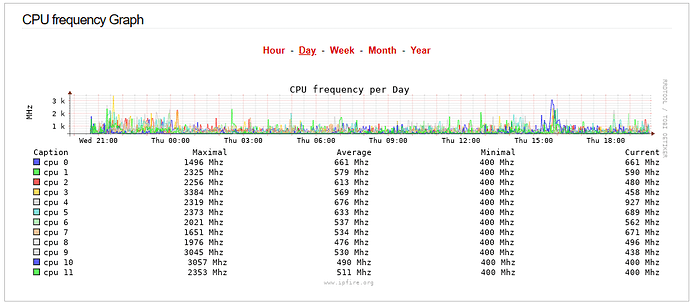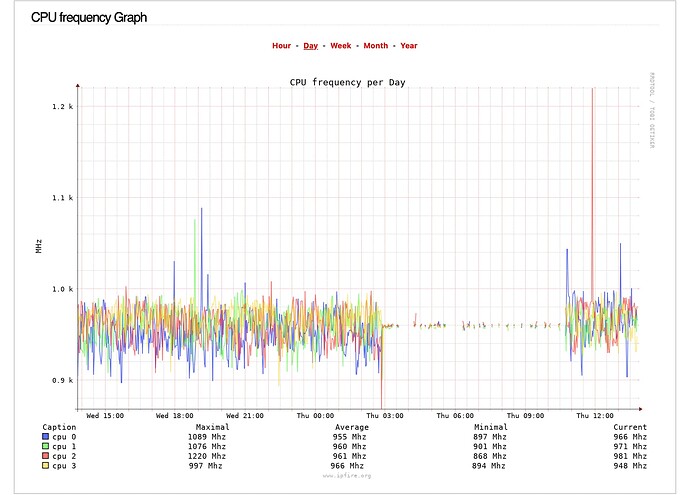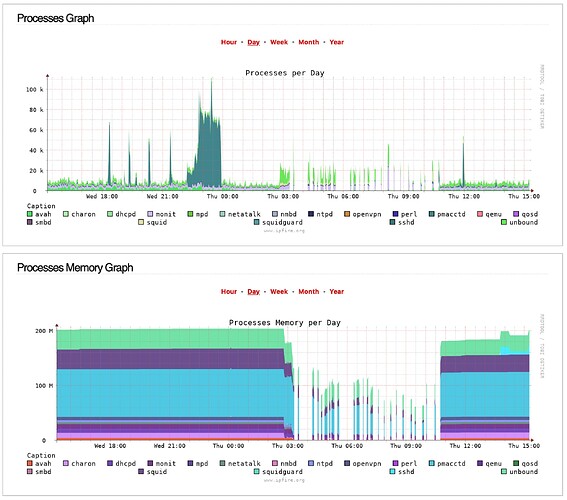I tried this from the wiki
wiki.ipfire.org - Migrate to new hardware
And other than purging all the graph information that was cumulated, nothing else has happened (so the same error in the CPU Frequency Graph
I also installed cpufreq-info and apparently it’s returning information (no error)
Should I just get used to the fact that RRD graphs do not work?
cpufrequtils 008: cpufreq-info (C) Dominik Brodowski 2004-2009
Report errors and bugs to cpufreq@vger.kernel.org, please.
analyzing CPU 0:
driver: acpi-cpufreq
CPUs which run at the same hardware frequency: 0
CPUs which need to have their frequency coordinated by software: 0
maximum transition latency: 10.0 us.
hardware limits: 400 MHz - 2.50 GHz
available frequency steps: 2.50 GHz, 2.50 GHz, 2.30 GHz, 2.20 GHz, 2.00 GHz, 1 .90 GHz, 1.70 GHz, 1.60 GHz, 1.30 GHz, 1.20 GHz, 1.10 GHz, 1000 MHz, 800 MHz, 70 0 MHz, 500 MHz, 400 MHz
available cpufreq governors: conservative, ondemand, userspace, powersave, per formance, schedutil
current policy: frequency should be within 400 MHz and 2.50 GHz.
The governor "ondemand" may decide which speed to use
within this range.
current CPU frequency is 400 MHz (asserted by call to hardware).
cpufreq stats: 2.50 GHz:0.67%, 2.50 GHz:0.00%, 2.30 GHz:0.01%, 2.20 GHz:0.01%, 2.00 GHz:0.01%, 1.90 GHz:0.03%, 1.70 GHz:0.02%, 1.60 GHz:0.02%, 1.30 GHz:0.05%, 1.20 GHz:0.39%, 1.10 GHz:0.11%, 1000 MHz:0.25%, 800 MHz:0.87%, 700 MHz:0.35%, 5 00 MHz:17.93%, 400 MHz:79.29% (1172)
analyzing CPU 1:
driver: acpi-cpufreq
CPUs which run at the same hardware frequency: 1
CPUs which need to have their frequency coordinated by software: 1
maximum transition latency: 10.0 us.
hardware limits: 400 MHz - 2.50 GHz
available frequency steps: 2.50 GHz, 2.50 GHz, 2.30 GHz, 2.20 GHz, 2.00 GHz, 1 .90 GHz, 1.70 GHz, 1.60 GHz, 1.30 GHz, 1.20 GHz, 1.10 GHz, 1000 MHz, 800 MHz, 70 0 MHz, 500 MHz, 400 MHz
available cpufreq governors: conservative, ondemand, userspace, powersave, per formance, schedutil
current policy: frequency should be within 400 MHz and 2.50 GHz.
The governor "ondemand" may decide which speed to use
within this range.
current CPU frequency is 2.50 GHz (asserted by call to hardware).
cpufreq stats: 2.50 GHz:2.68%, 2.50 GHz:0.00%, 2.30 GHz:0.10%, 2.20 GHz:0.00%, 2.00 GHz:0.01%, 1.90 GHz:0.03%, 1.70 GHz:0.01%, 1.60 GHz:0.01%, 1.30 GHz:0.24%, 1.20 GHz:0.01%, 1.10 GHz:0.57%, 1000 MHz:0.14%, 800 MHz:0.47%, 700 MHz:0.56%, 5 00 MHz:6.25%, 400 MHz:88.91% (633)
analyzing CPU 2:
driver: acpi-cpufreq
CPUs which run at the same hardware frequency: 2
CPUs which need to have their frequency coordinated by software: 2
maximum transition latency: 10.0 us.
hardware limits: 400 MHz - 2.50 GHz
available frequency steps: 2.50 GHz, 2.50 GHz, 2.30 GHz, 2.20 GHz, 2.00 GHz, 1 .90 GHz, 1.70 GHz, 1.60 GHz, 1.30 GHz, 1.20 GHz, 1.10 GHz, 1000 MHz, 800 MHz, 70 0 MHz, 500 MHz, 400 MHz
available cpufreq governors: conservative, ondemand, userspace, powersave, per formance, schedutil
current policy: frequency should be within 400 MHz and 2.50 GHz.
The governor "ondemand" may decide which speed to use
within this range.
current CPU frequency is 400 MHz (asserted by call to hardware).
cpufreq stats: 2.50 GHz:6.91%, 2.50 GHz:0.00%, 2.30 GHz:0.01%, 2.20 GHz:0.04%, 2.00 GHz:0.02%, 1.90 GHz:0.02%, 1.70 GHz:0.06%, 1.60 GHz:0.04%, 1.30 GHz:0.11%, 1.20 GHz:0.16%, 1.10 GHz:0.27%, 1000 MHz:0.55%, 800 MHz:0.74%, 700 MHz:1.60%, 5 00 MHz:8.83%, 400 MHz:80.63% (1473)
analyzing CPU 3:
driver: acpi-cpufreq
CPUs which run at the same hardware frequency: 3
CPUs which need to have their frequency coordinated by software: 3
maximum transition latency: 10.0 us.
hardware limits: 400 MHz - 2.50 GHz
available frequency steps: 2.50 GHz, 2.50 GHz, 2.30 GHz, 2.20 GHz, 2.00 GHz, 1 .90 GHz, 1.70 GHz, 1.60 GHz, 1.30 GHz, 1.20 GHz, 1.10 GHz, 1000 MHz, 800 MHz, 70 0 MHz, 500 MHz, 400 MHz
available cpufreq governors: conservative, ondemand, userspace, powersave, per formance, schedutil
current policy: frequency should be within 400 MHz and 2.50 GHz.
The governor "ondemand" may decide which speed to use
within this range.
current CPU frequency is 500 MHz (asserted by call to hardware).
cpufreq stats: 2.50 GHz:1.32%, 2.50 GHz:0.00%, 2.30 GHz:0.00%, 2.20 GHz:0.04%, 2.00 GHz:0.01%, 1.90 GHz:0.01%, 1.70 GHz:0.06%, 1.60 GHz:0.02%, 1.30 GHz:0.04%, 1.20 GHz:0.02%, 1.10 GHz:0.33%, 1000 MHz:0.20%, 800 MHz:0.26%, 700 MHz:1.53%, 5 00 MHz:8.74%, 400 MHz:87.41% (1182)
analyzing CPU 4:
driver: acpi-cpufreq
CPUs which run at the same hardware frequency: 4
CPUs which need to have their frequency coordinated by software: 4
maximum transition latency: 10.0 us.
hardware limits: 400 MHz - 2.50 GHz
available frequency steps: 2.50 GHz, 2.50 GHz, 2.30 GHz, 2.20 GHz, 2.00 GHz, 1 .90 GHz, 1.70 GHz, 1.60 GHz, 1.30 GHz, 1.20 GHz, 1.10 GHz, 1000 MHz, 800 MHz, 70 0 MHz, 500 MHz, 400 MHz
available cpufreq governors: conservative, ondemand, userspace, powersave, per formance, schedutil
current policy: frequency should be within 400 MHz and 2.50 GHz.
The governor "ondemand" may decide which speed to use
within this range.
current CPU frequency is 400 MHz (asserted by call to hardware).
cpufreq stats: 2.50 GHz:4.05%, 2.50 GHz:0.00%, 2.30 GHz:0.19%, 2.20 GHz:0.02%, 2.00 GHz:0.01%, 1.90 GHz:0.06%, 1.70 GHz:0.04%, 1.60 GHz:0.09%, 1.30 GHz:0.08%, 1.20 GHz:0.22%, 1.10 GHz:0.03%, 1000 MHz:0.20%, 800 MHz:0.37%, 700 MHz:0.66%, 5 00 MHz:5.35%, 400 MHz:88.65% (868)
analyzing CPU 5:
driver: acpi-cpufreq
CPUs which run at the same hardware frequency: 5
CPUs which need to have their frequency coordinated by software: 5
maximum transition latency: 10.0 us.
hardware limits: 400 MHz - 2.50 GHz
available frequency steps: 2.50 GHz, 2.50 GHz, 2.30 GHz, 2.20 GHz, 2.00 GHz, 1 .90 GHz, 1.70 GHz, 1.60 GHz, 1.30 GHz, 1.20 GHz, 1.10 GHz, 1000 MHz, 800 MHz, 70 0 MHz, 500 MHz, 400 MHz
available cpufreq governors: conservative, ondemand, userspace, powersave, per formance, schedutil
current policy: frequency should be within 400 MHz and 2.50 GHz.
The governor "ondemand" may decide which speed to use
within this range.
current CPU frequency is 400 MHz (asserted by call to hardware).
cpufreq stats: 2.50 GHz:4.32%, 2.50 GHz:0.00%, 2.30 GHz:0.00%, 2.20 GHz:0.00%, 2.00 GHz:0.54%, 1.90 GHz:0.01%, 1.70 GHz:0.14%, 1.60 GHz:0.24%, 1.30 GHz:0.01%, 1.20 GHz:0.00%, 1.10 GHz:0.19%, 1000 MHz:0.46%, 800 MHz:2.19%, 700 MHz:2.27%, 5 00 MHz:5.80%, 400 MHz:83.84% (538)
analyzing CPU 6:
driver: acpi-cpufreq
CPUs which run at the same hardware frequency: 6
CPUs which need to have their frequency coordinated by software: 6
maximum transition latency: 10.0 us.
hardware limits: 400 MHz - 2.50 GHz
available frequency steps: 2.50 GHz, 2.50 GHz, 2.30 GHz, 2.20 GHz, 2.00 GHz, 1 .90 GHz, 1.70 GHz, 1.60 GHz, 1.30 GHz, 1.20 GHz, 1.10 GHz, 1000 MHz, 800 MHz, 70 0 MHz, 500 MHz, 400 MHz
available cpufreq governors: conservative, ondemand, userspace, powersave, per formance, schedutil
current policy: frequency should be within 400 MHz and 2.50 GHz.
The governor "ondemand" may decide which speed to use
within this range.
current CPU frequency is 400 MHz (asserted by call to hardware).
cpufreq stats: 2.50 GHz:2.34%, 2.50 GHz:0.00%, 2.30 GHz:0.00%, 2.20 GHz:0.00%, 2.00 GHz:0.00%, 1.90 GHz:0.00%, 1.70 GHz:0.06%, 1.60 GHz:0.00%, 1.30 GHz:0.00%, 1.20 GHz:0.09%, 1.10 GHz:0.09%, 1000 MHz:0.35%, 800 MHz:0.61%, 700 MHz:0.85%, 5 00 MHz:2.21%, 400 MHz:93.40% (391)
analyzing CPU 7:
driver: acpi-cpufreq
CPUs which run at the same hardware frequency: 7
CPUs which need to have their frequency coordinated by software: 7
maximum transition latency: 10.0 us.
hardware limits: 400 MHz - 2.50 GHz
available frequency steps: 2.50 GHz, 2.50 GHz, 2.30 GHz, 2.20 GHz, 2.00 GHz, 1 .90 GHz, 1.70 GHz, 1.60 GHz, 1.30 GHz, 1.20 GHz, 1.10 GHz, 1000 MHz, 800 MHz, 70 0 MHz, 500 MHz, 400 MHz
available cpufreq governors: conservative, ondemand, userspace, powersave, per formance, schedutil
current policy: frequency should be within 400 MHz and 2.50 GHz.
The governor "ondemand" may decide which speed to use
within this range.
current CPU frequency is 400 MHz (asserted by call to hardware).
cpufreq stats: 2.50 GHz:2.81%, 2.50 GHz:0.00%, 2.30 GHz:0.00%, 2.20 GHz:0.01%, 2.00 GHz:0.00%, 1.90 GHz:0.00%, 1.70 GHz:0.00%, 1.60 GHz:0.00%, 1.30 GHz:0.00%, 1.20 GHz:0.12%, 1.10 GHz:0.00%, 1000 MHz:0.41%, 800 MHz:1.90%, 700 MHz:1.04%, 5 00 MHz:1.98%, 400 MHz:91.72% (142)
analyzing CPU 8:
driver: acpi-cpufreq
CPUs which run at the same hardware frequency: 8
CPUs which need to have their frequency coordinated by software: 8
maximum transition latency: 10.0 us.
hardware limits: 400 MHz - 2.50 GHz
available frequency steps: 2.50 GHz, 2.50 GHz, 2.30 GHz, 2.20 GHz, 2.00 GHz, 1 .90 GHz, 1.70 GHz, 1.60 GHz, 1.30 GHz, 1.20 GHz, 1.10 GHz, 1000 MHz, 800 MHz, 70 0 MHz, 500 MHz, 400 MHz
available cpufreq governors: conservative, ondemand, userspace, powersave, per formance, schedutil
current policy: frequency should be within 400 MHz and 2.50 GHz.
The governor "ondemand" may decide which speed to use
within this range.
current CPU frequency is 400 MHz (asserted by call to hardware).
cpufreq stats: 2.50 GHz:2.82%, 2.50 GHz:0.00%, 2.30 GHz:0.01%, 2.20 GHz:0.00%, 2.00 GHz:0.00%, 1.90 GHz:0.00%, 1.70 GHz:0.00%, 1.60 GHz:0.00%, 1.30 GHz:0.21%, 1.20 GHz:0.25%, 1.10 GHz:0.00%, 1000 MHz:0.00%, 800 MHz:1.11%, 700 MHz:0.79%, 5 00 MHz:5.43%, 400 MHz:89.37% (307)
analyzing CPU 9:
driver: acpi-cpufreq
CPUs which run at the same hardware frequency: 9
CPUs which need to have their frequency coordinated by software: 9
maximum transition latency: 10.0 us.
hardware limits: 400 MHz - 2.50 GHz
available frequency steps: 2.50 GHz, 2.50 GHz, 2.30 GHz, 2.20 GHz, 2.00 GHz, 1 .90 GHz, 1.70 GHz, 1.60 GHz, 1.30 GHz, 1.20 GHz, 1.10 GHz, 1000 MHz, 800 MHz, 70 0 MHz, 500 MHz, 400 MHz
available cpufreq governors: conservative, ondemand, userspace, powersave, per formance, schedutil
current policy: frequency should be within 400 MHz and 2.50 GHz.
The governor "ondemand" may decide which speed to use
within this range.
current CPU frequency is 2.50 GHz (asserted by call to hardware).
cpufreq stats: 2.50 GHz:7.09%, 2.50 GHz:0.00%, 2.30 GHz:0.00%, 2.20 GHz:0.00%, 2.00 GHz:0.00%, 1.90 GHz:0.00%, 1.70 GHz:0.00%, 1.60 GHz:0.01%, 1.30 GHz:0.14%, 1.20 GHz:0.00%, 1.10 GHz:0.34%, 1000 MHz:0.00%, 800 MHz:1.40%, 700 MHz:1.20%, 5 00 MHz:9.36%, 400 MHz:80.45% (229)
analyzing CPU 10:
driver: acpi-cpufreq
CPUs which run at the same hardware frequency: 10
CPUs which need to have their frequency coordinated by software: 10
maximum transition latency: 10.0 us.
hardware limits: 400 MHz - 2.50 GHz
available frequency steps: 2.50 GHz, 2.50 GHz, 2.30 GHz, 2.20 GHz, 2.00 GHz, 1 .90 GHz, 1.70 GHz, 1.60 GHz, 1.30 GHz, 1.20 GHz, 1.10 GHz, 1000 MHz, 800 MHz, 70 0 MHz, 500 MHz, 400 MHz
available cpufreq governors: conservative, ondemand, userspace, powersave, per formance, schedutil
current policy: frequency should be within 400 MHz and 2.50 GHz.
The governor "ondemand" may decide which speed to use
within this range.
current CPU frequency is 400 MHz (asserted by call to hardware).
cpufreq stats: 2.50 GHz:1.33%, 2.50 GHz:0.00%, 2.30 GHz:0.00%, 2.20 GHz:0.00%, 2.00 GHz:0.11%, 1.90 GHz:0.00%, 1.70 GHz:0.00%, 1.60 GHz:0.00%, 1.30 GHz:0.00%, 1.20 GHz:0.00%, 1.10 GHz:0.00%, 1000 MHz:0.03%, 800 MHz:0.43%, 700 MHz:0.11%, 5 00 MHz:3.83%, 400 MHz:94.16% (108)
analyzing CPU 11:
driver: acpi-cpufreq
CPUs which run at the same hardware frequency: 11
CPUs which need to have their frequency coordinated by software: 11
maximum transition latency: 10.0 us.
hardware limits: 400 MHz - 2.50 GHz
available frequency steps: 2.50 GHz, 2.50 GHz, 2.30 GHz, 2.20 GHz, 2.00 GHz, 1 .90 GHz, 1.70 GHz, 1.60 GHz, 1.30 GHz, 1.20 GHz, 1.10 GHz, 1000 MHz, 800 MHz, 70 0 MHz, 500 MHz, 400 MHz
available cpufreq governors: conservative, ondemand, userspace, powersave, per formance, schedutil
current policy: frequency should be within 400 MHz and 2.50 GHz.
The governor "ondemand" may decide which speed to use
within this range.
current CPU frequency is 400 MHz (asserted by call to hardware).
cpufreq stats: 2.50 GHz:1.95%, 2.50 GHz:0.00%, 2.30 GHz:0.00%, 2.20 GHz:0.00%, 2.00 GHz:0.00%, 1.90 GHz:0.02%, 1.70 GHz:0.00%, 1.60 GHz:0.19%, 1.30 GHz:0.68%, 1.20 GHz:0.33%, 1.10 GHz:0.05%, 1000 MHz:0.02%, 800 MHz:0.04%, 700 MHz:0.17%, 5 00 MHz:5.50%, 400 MHz:91.05% (194)



